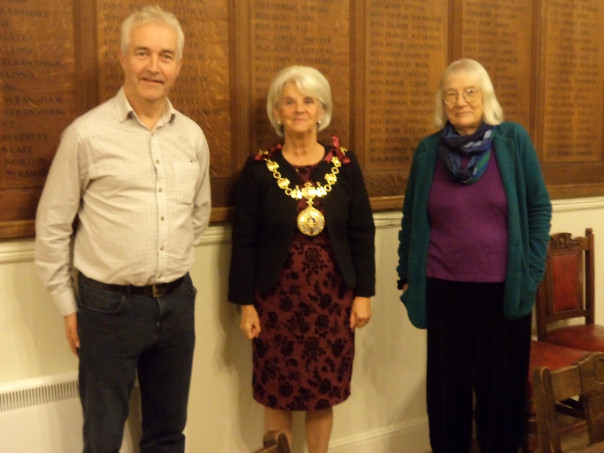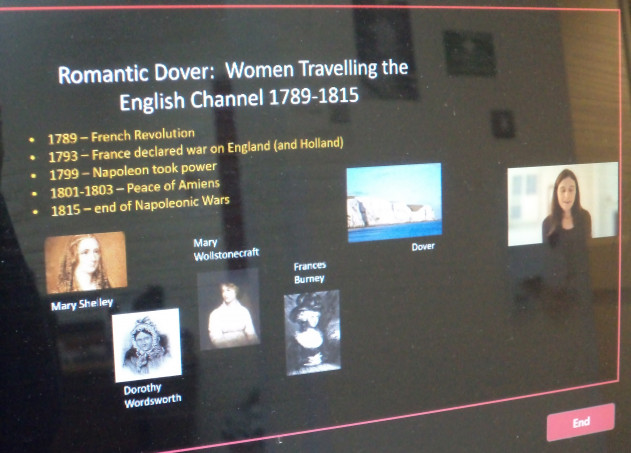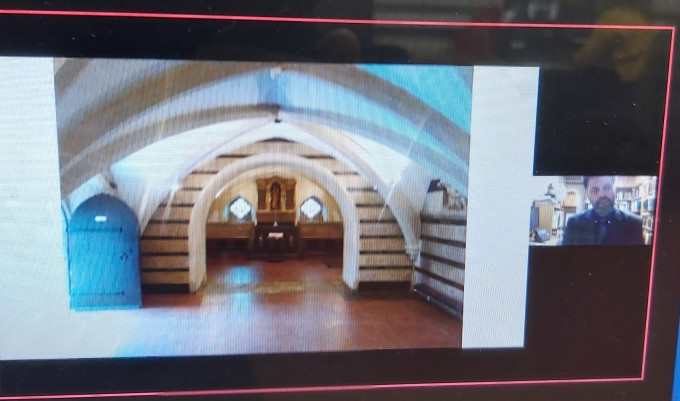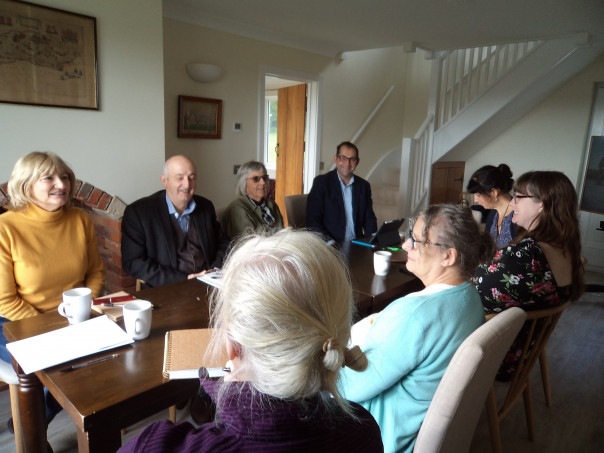I thought I would start where I left off last week to say that we had a very successful book launch involving the editors, many of the contributors and Professor Kerry Brown, President of KAS, one of the sponsors. Consequently, I would like to thank Cllr Alison Reynolds, the Mayor of Faversham, for allowing us to use Faversham Guildhall and also to thank Peter Hobbs for sponsoring the light refreshments, as well as contributing towards the book’s publication. Equally, thanks to Martin Edwards for organising the catering, it was great to have his professional expertise.

This just leaves me to highlight again the upcoming ‘Maritime Kent: Charting new Waters’ conference that will take place at CCCU on Saturday 6 November. The conference is free but please book at: https://tinyurl.com/maritimekent and any problems email artsandculture@canterbury.ac.uk for assistance. Among the speakers are Andrew Lambert on Kent’s strategic position to command the northern seas and Carol Stewart on Black people in modern times in the Medway area. See next week’s blog for the livestreaming links if you cannot attend in person.
We have had yet another busy week at CKHH because in addition to three more online lectures in conjunction with the Canterbury Festival, I have had an in-person meeting of the Lossenham Project wills group on Thursday at Lossenham Priory Farmhouse and then on Friday another Festival walk – a reprise of ‘Everyday Life in Late Medieval Canterbury’ with twelve more people on behalf of CAT, while Dr Diane Heath has her first awayday NHLF ‘Medieval Animals Heritage’ event at Wildwood on Friday as well.

Although I won’t be able to squeeze in the Friday events into the blog this week because it needs to come out by that morning, I thought I would mention them for completeness because the blog is an excellent record of previous events and activities, as well as historical information and knowledge, and news of upcoming events locally and regionally. In that light, I’ll just mention ‘Exploring Medieval Canterbury’ a lecture by Professor Paul Bennett on Thursday 11 November in Sandwich Guildhall at 7.30. For tickets at £5 please contact 01304 617197 and it will also be possible to book to see the presentation on Zoom.
To return to the three CKHH and Festival lectures, the first on Tuesday evening was given by Dr Susan Civale, a Senior Lecturer in Romanticism at CCCU, who has a special interest in women writers who crossed mountains, lakes and seas, and who managed to negotiate not only the physical landscape but also the cultural and social restrictions of the late 18th and early 19th centuries, detailing their responses in journals, poetry and novels. Furthermore, these women were responding to their personal emotional and often ‘romantic’ with a small ‘r’ situations, whether as lovers, wives, daughters or sisters which placed further strains on them as they crossed the narrow seas from Dover to continental Europe, sometimes only returning years later.
I’ll just mention three of the women Susan was observing, firstly Mary Shelley and the mother she never knew except through her writings – Mary Wollstonecraft. For Wollstonecraft, whose earlier travelogue had seen Dover as a place of discomfort, if not emotional pain, a dirty, insignificant place, the town is viewed as contrasting poorly with the pristine world of Scandinavia in which Wollstonecraft had been travelling before her return to the grubby world of England. Now this sense of dirt was synonymous for her with rejection by her lover residing in London, her sense of isolation and spatial displacement made worse by the presence of her young daughter who was seemingly oblivious to her mother’s sadness.

In contrast for Mary Shelley travelling in the opposite direction Dover was the gateway, the place that would give her and her lover/husband freedom leaving behind her disapproving father and the restrictions of English society. Thus, while the boat trip across the Channel was difficult in the face of the storm and terrible seasickness, Calais brought a beautiful sunrise, wonderful colours and a cloudless sky as well as independence, love and freedom. This playing off of Calais and Dover was something Dorothy Wordsworth had deployed twelve years earlier in 1802, seeing Dover illuminated – naturally and men-made, while Calais was dark in comparison as a place of desertion bringing on a sense of melancholy. As a consequence of her thoughtful analysis, Susan’s lecture was warmly appreciated by her audience, drawing a wide range of questions, including one from a Dover resident.
Moving on to Wednesday, our speaker was Michelle Crowther, the Learning and Teaching Librarian for the Humanities at CCCU. She is also studying The Persistent Scribblers Society of Canterbury for her doctorate, which was the subject of her talk yesterday. This group of 22 women and 3 men who were largely linked to the cathedral community of Canterbury were busy writing poems and short stories between 1875 and 1879. These writings were then circulated among a group of 103 subscribers as packets of original papers six times a year. The idea was that readers had a day to work through the entries, vote for their favourite and send them on using the reliable postal system. Once back at their departure point the votes were counted up and each year a prize was given to the person who had received the most votes. As Michelle said, this Society drew on networks among the Anglican clergy, old boy associations and those linked to Oxford colleges, as well as familial and fraternal ties, creating a web that stretched from Kent to Gloucestershire with outriders as far away as Scotland.

For such a group, albeit there were some young writers, as well as their parents who espoused conservative, genteel opinions, the topics might be said to reflect this section of Victorian society. Nevertheless, this might be seen as the beginnings of some changes or at the very least discussion of issues such as suffrage and opportunities for women to receive more than a basic education. Michelle in her presentation looked at the ways the Scribblers tackled three topics: lady-helps and gentleman-helps, gossip, and old maids, and one wonders whether the interest by the Scribblers in lady-helps and old maids was in some ways a collective anxiety that daughters, nieces and aunts might indeed find themselves in such positions in reality not just in fiction.
At the conclusion of a stimulating lecture, and who could forget Mrs Crawshay’s experiment of ‘helping’ her new lady-helps by inexpertly helping them to dust the stairs, it was clear that some of the Scribblers, at least, were equally uncomfortable with this idea of young gentlewomen caught on the margins of this Upstairs/Downstairs world – seeing themselves not as servants ie working class, yet neither quite welcome in the drawing room either. This generated a flurry of questions, and the audience was interested in both how the Society functioned practically and whether they were really prepared to take on current contentious issues in Victorian society.

For the final presentation on Thursday (this evening) Dr Ralph Norman explored a very topical subject in the activities of African scholars at St Augustine’s Missionary College in the Victorian era. This was in the exceedingly capable hands of Claire Bartram and Diane Heath, with Toby Charlton-Taylor from AV in the background if required. However, I’m not going to say anything about this beyond I hope you caught it as it was advertised in the blog a fortnight ago and I am sure it was absolutely fascinating, and instead, I am going to report on the Lossenham Project wills group meeting that took place at Newenden today.
Before I come to the meeting, I want to thank The Janus Foundation for providing the venue and lunch, which was lovely, and it was great that at least most of the group had finally managed to gather in one room rather than just meeting online. After an initial coffee, we decided it made most sense to have a couple of the presentations before lunch. So our first speaker was Annie Partridge. Annie has been working on the Northiam wills and has been making a special study of William Harrison and his links to Great Dixter. In particular, she has been exploring his familial links across several parishes and the formation of William’s household and how he wished to control this beyond the grave through the provisions he made for his wife, his children and his nieces and nephews. She is also examining his landed interests and his farming practices, which seem to have involved mixed farming with cattle as the main livestock.
This was an excellent start and highlighted several of the themes that were to recur throughout the meeting, including in Sue Hatt and Celia Jennings’ presentation that was next. They have been busy looking at the social and economic history of Benenden, Rolvenden and Tenterden through the activities of women. Thus, even though women were hardly ever the makers of wills, and documents more generally, they were often mentioned as wives, daughters, mothers and sisters who were expected to take responsibility for something among the testator’s assets or land holdings. This status and economic position saw, for example, one mother receive a brick field, while a sister and her children were to receive a wine licence. Moreover, others were given a section of the family home in which to maintain their own household, which might include named rooms, ingress and egress, access to fuelwood, a hearth and the well, as well as provisions such as livestock, corn and malt. For their assessment, they are also starting to investigate religious views, attitudes towards the poor and land use, already seeing differences between Rolvenden and Tenterden. This is potentially a large project, not least because once we have access to the wills of lower courts this will open up the study tremendously, not least because it may be possible to match up inventories to surviving houses.
After lunch Keith Bailey explained how he has been tracing the Brykenden family of Smallhythe and Biddenden, which has similarly shown the importance of social network analysis, albeit this needs to be undertaken carefully because some families only used a very small pool of forenames, which might lead to a grandfather, father and one or two siblings all sharing the same names, often John! Due to Robert Brykenden’s position at Smallhythe as clerk of the king’s ships, Keith has also been exploring shipbuilding between Smallhythe and Reding Street, including looking at the earlier research of the Romney Marsh Research Trust, such as its small ports project. Again, this has thrown up the importance and frequency of the web of contacts across parishes either side of the Kent/Sussex border, and this family also offers a way to examine the spectrum across religious orthodoxy and heterodoxy, typified by the wills of those who worshipped at St Mildred’s, Tenterden and the chapel at Smallhythe.
Jane Richardson took us to the very small collection of PCC wills from pre-1560 Newenden, although even adding in those from the lower courts will not give us a large cohort due to the small size of the parish. One of her wills seems to have been made by the parish priest not long before the dissolution of Lossenham Priory, whose beneficiaries included three of the friars at the Carmelite house, as well as two local priests. The two lay testators confirm rather than extend our knowledge of Newenden church, for as Jane pointed out we only have mentioned three altars; the high altar, that in the Lady Chapel and another linked to the Rood. Such references are important because the church has been much restored and altered in modern times. Thus, Jane and Sophie (who was not able to attend the meeting today) hope that the lower court wills can provide valuable additional evidence regarding the church and the friary.

Jason Mazzocchi took us to early 19th-century Newenden through his work on the will of Samual Bishop who effectively held the parish of Newenden and even beyond the parish boundary, as well as having business interests in London and overseas. He was childless at his death and his will reveals familial and affinal networks, the apparent trust he placed in his wife and his seeming desire for communal memory and commemoration through the establishing of a charitable endowment to provide education for the village boys. Such commemoration is an important aspect of Jason’s project and the role and value of gifts for the poor was picked up by Rebecca in the last presentation.
However, before that we heard from Sue Muddiman, who discussed the potential of gathering statistical information from the database and how this can shape a quantitative analysis of our material. Consequently, Sue outlined a range of potential ways this could be done, including social network analysis, basic linking of personal names and parishes, and mapping distributions of wills over time. Keeping with the concept of mapping, Sue drew attention to the value of using the database to examine the distribution of features in the landscape such as mills, but also naming practices and all agreed a glossary of Kent/Sussex household and farming vocabulary would be valuable.
For the final presentation, Dr Rebecca Warren similarly focused on potential, using as her analytical feature gifts to the poor primarily in the wills of Northiam. Thus, she was able to demonstrate the potential of the database, mapping the parishes of these charitable bequests that may represent, for example, business connections, familial and affinal links, migration or any combination of these. Of special interest was the apparent early use of the poor man’s box at Northiam – pre-Reformation, and a bequest of clothing specifically for children.
This was a great way to end the presentations because it underlined many of the points raised during our discussions, as well as pointing to the potential of the database, which hopefully has spurred members of the group to keep adding transcriptions in addition to putting wills onto the database. This seems highly likely from the level of general engagement during the various discussions throughout the meeting and hopefully everyone went away feeling that their contribution is being valued within this co-operative and collaborative project. The next step will be a meeting of all the group on Zoom next month when we may have details on the probate digitization. So my thanks to everyone who took part today and to The Janus Foundation for facilitating our meeting.
 Centre for Kent History and Heritage
Centre for Kent History and Heritage Sheila Sweetinburgh
Sheila Sweetinburgh 1343
1343

